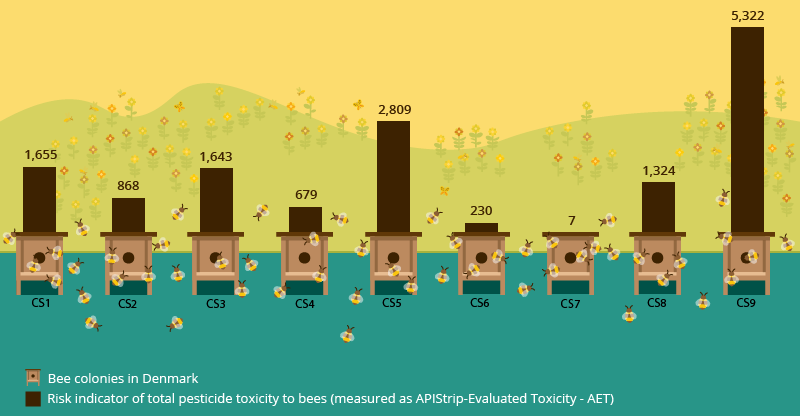Biodiversity Signal 1: Light pollution — a neglected environmental threat to biodiversity?
In Europe, modern infrastructure is constantly developing and urban areas are expanding. This causes artificial light emissions to rise. Artificial light at night is scattered in the lower atmosphere, creating light pollution in both urban areas and the surrounding nocturnal ecosystems (stripping them of darkness as a result).
Many Europeans live under light-polluted skies. Street lamps, lighting installations on construction sites or in business buildings, and floodlights for sports facilities or offshore oil platforms are all examples of contributing sources. Thanks to satellite imagery, the change in terrestrial surface exposed to light emissions has been assessed over the past 8 years as part of work completed by the European Topic Centre on Human Health and the Environment(ETC HE) (Widmer et al., 2022).
Places with natural light conditions are reducing
Light pollution can affect both human health and wildlife. The effects of light pollution on human health include disrupted sleeping patterns, cancer, depression and weight gain, which are the four most heavily researched health outcomes. Light pollution can also harm wildlife patterns by altering individual behaviour; often, this leads to drastic and potentially negative effects on biological rhythms, daily activity and reproduction (Raap et al., 2015).
‘Truly dark spaces’ are areas minimally exposed to artificial light below a specific light threshold. Such areas in the EU-27 shrank by 5% between 2014-2015 and 2020-2021 (Map 1).
Although further research is needed, and there are no EU legislative limits on light pollution, the available evidence shows that light pollution can have a significant impact on ecosystems. More work is needed to expand knowledge in this area and identify the necessary legislative response.

Note: VIIRS - Visible Infrared Imaging Radiometer Suite. The Northern region has been excluded from the map due to the confounding effects of Aurora lights as detailed in Widmer et al. (2022). The value of 0.5 nW/cm2/sr was chosen as the threshold as it reflects the natural luminance of the night sky with a margin for uncertainties.
Source: : Widmer et al. (2022). The provider of the original dataset is the Earth Observation Group, Payne Institute for Public Policy, Colorado School of Mines: VIIRS Nighttime Light (mines.edu) (Elvidge et al., 2021). Data are processed in Google Earth Engine API using the following data-catalog: https://developers.google.com/earth-engine/datasets/catalog/NOAA_VIIRS_DNB_MONTHLY_V1_VCMSLCFG.
Click here to view the figure enlarged
Click here for different chart formats and data
References
Elvidge, C.D., et al., 2021, ‘Annual time series of global VIIRS nighttime lights derived from monthly averages: 2012 to 2019’, Remote Sensing 13, 5: 922, https://doi.org/10.3390/rs13050922.
Raap, T., et al., 2015, ‘Light pollution disrupts sleep in free-living animals’, Scientific Reports 5, 13557 (https://doi.org/10.1038/srep13557).
Widmer, K., et al., 2022, Review and Assessment of Available Information on Light Pollution in Europe, ETC/HE Report 2022/11 (https://www.eionet.europa.eu/etcs/etc-he/products/etc-he-products/etc-he-report-2022-8-review-and-assessment-of-available-information-on-light-pollution-in-europe) accessed 7 November 2022.
Biodiversity Signal 2: Understanding pesticide impacts on pollinators
In Europe, a vast variety of insects pollinate food crops and wild plant species. Pollinators play a vital role in maintaining healthy ecosystems and providing healthy food for us to eat. The number of pollinators in Europe is in decline; we need to take action to reverse this trend to protect natural environments and the well-being of citizens (European Commission, 2022).
Insignia is a citizen-science-based project that uses bee colonies as markers for pesticides.
A pilot study completed in Denmark in 2020 in nine geographically separated bee colonies detected 75 different pesticide residues — including the highly persistent pesticide DDT, which has been banned since the early 1970s. Figure 1 shows the toxicity to bees of pesticides identified at each of the locations. The data collected by the project also indicate a seasonal variation, with increased detection when these pesticides are more frequently used in agricultural activities.

Notes: The location of each colony (CS1, CS2, etc.) can be found in Murcia-Morales et al. (2021).
Source: Murcia-Morales et al. (2021).
Over the coming years, the project will assess other environmental pollutants such as heavy metals, microplastics and fine dust/particulate matter.
This project demonstrates an innovative approach to monitoring the health of the environment and pollution’s impacts on both ecosystem and human health. Using bee colonies in this way provides regular data illustrating how human activity affects sensitive ecosystems and pollinators. More information is available on the Insignia project website (https://www.insignia-bee.eu/).
Cover image source: © Panagiotis Dalagiorgos, Well with Nature /EEA


Document Actions
Share with others